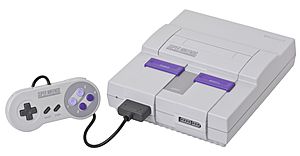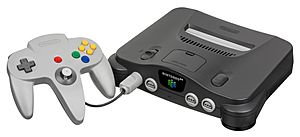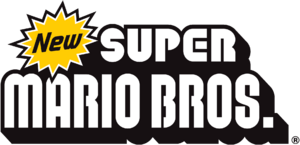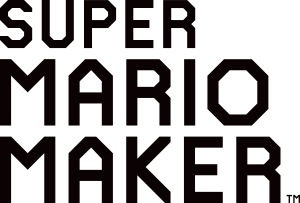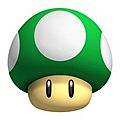Super Mario facts for kids
Quick facts for kids Super Mario |
|
|---|---|

Logo since 2011
|
|
| Genre | Platform |
| Developers |
|
| Publisher | Nintendo |
| Creator | Shigeru Miyamoto |
| Artists |
|
| Composers |
|
| Platforms | |
| First release | Super Mario Bros. September 13, 1985 |
| Latest release | Super Mario Bros. Wonder October 20, 2023 |
| Spin-offs | Luigi Yoshi Wario Mario Kart Mario Party Paper Mario Mario & Luigi |
Super Mario (also known as Super Mario Bros. and Mario ) is a super popular platform game series. It was created by Nintendo and stars their famous character, Mario. This series is the main part of the bigger Mario franchise.
Almost every major Nintendo game console has had a Super Mario game. There have also been some Super Mario games on other gaming platforms. The series has more than 20 games!
Super Mario games mostly take place in the make-believe Mushroom Kingdom. You usually play as Mario, often with his brother, Luigi, and other friends from the Mario world. As platform games, you run and jump across platforms. You also jump on top of enemies in different themed levels. The stories are usually simple: Mario and Luigi rescue the kidnapped Princess Peach from the main bad guy, Bowser.
The first game, Super Mario Bros., came out in 1985 for the Nintendo Entertainment System (NES). It set up all the main ideas for the series. This includes many power-ups and items that give characters special powers. For example, you can throw fireballs or change size.
The Super Mario series is part of the larger Mario world. This world includes other types of video games, movies, TV shows, books, and toys. More than 380 million Super Mario games have been sold worldwide. This makes it the fifth-bestselling video game series ever!
Contents
How Do You Play Super Mario Games?
The goal of Super Mario games is to move through levels. You beat enemies, collect items, and solve puzzles. You try not to lose a life. Using power-ups is a very important part of the games.
The series has games that are both 2D (flat) and 3D (with depth).
Playing in 2D
In the 2D games, your character (usually Mario) jumps on platforms and enemies. You avoid attacks and move to the right side of the screen. These levels usually have one exit. You need to reach it within a time limit to get to the next level.
Super Mario Bros. 3 added an overworld. This is a map of levels that you can choose to play in different orders. Super Mario World then added levels with more than one exit.
Playing in 3D
3D Super Mario games come in two main types:
- Open-world games: Games like 64, Sunshine, and Odyssey let you explore big areas freely. You can move in any direction. As you play, more areas become open to explore.
- Linear 3D games: Games like Galaxy, Galaxy 2, 3D Land, and 3D World have more fixed camera angles. You follow a set path to reach a single goal.
Who Can You Play As?
You can often play as characters other than Mario, like Luigi. In older games, two players would take turns controlling Mario and Luigi. Luigi is sometimes playable by the first player in harder versions of the game. He might have lower gravity or slide more.
Newer games let up to four players play at the same time. Other playable characters include Toads, Peach, Yoshi, Wario, Rosalina, Miis, Toadette, Nabbit, Daisy, and Bowser Jr. Each character sometimes has special skills.
Awesome Power-ups and Transformations
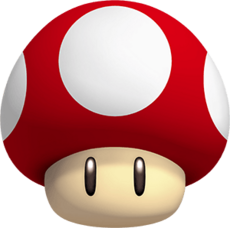
Mushroom power-ups are in almost every Super Mario game. The most famous is the Super Mushroom.
- Super Mushroom: This makes your character bigger, turning them into a "Super" version. They can then break certain blocks. If an enemy hits them, they just shrink back down instead of losing a life.
- Fire Flower: This lets your character throw bouncing fireballs at enemies.
- Poison Mushroom: (from Super Mario Bros.: The Lost Levels) This one hurts you if you pick it up!
- Mini Mushroom: (from New Super Mario Bros.) This shrinks your character to a tiny size.
- Mega Mushroom: (from New Super Mario Bros.) This turns your character into a giant who can smash through enemies and the environment!
Super Mario Bros. 3 brought in suits, often based on animals or enemies.
- Raccoon Suit (Super Leaf): Gives you a tail for flying.
- Tanooki Suit: Also gives you a tail for flying. Plus, you can turn into an invincible statue for a few seconds.
- Hammer Bros. Suit: Lets Mario and Luigi throw hammers at enemies from far away.
Other cool suits in later games include the Frog Suit, Penguin Suit, Cat Suit, Boomerang Suit, and Bee Suit.
Shooting Projectiles
Flower power-ups let your character shoot things.
- Fire Flower: (from Super Mario Bros.) Turns you into a Fire version who can throw fireballs.
- Ice Flower: Lets you shoot ice balls. These freeze enemies into blocks of ice that you can use as platforms or throw.
- Gold Flower: (from New Super Mario Bros. 2) Lets you turn bricks into coins and get extra coins for beating enemies.
Koopa Shells are also a big projectile in the series. You can throw them to defeat enemies or get coins.
Yoshi can also breathe fire, freezing air, or spit seeds and enemies in some games. Other power-ups let you throw bombs, boomerangs, and even shoot cannonballs! In Odyssey, Mario can even take control of characters who can launch different projectiles.
Riding Animals and Vehicles
Sometimes you can ride animals or drive vehicles!
- Yoshi: Mario's dinosaur friend, Yoshi, has been a rideable character since Super Mario World. Yoshi can eat enemies, fly, and breathe fire. In some games, you play as Yoshi himself!
- Poochi: A dog in Yoshi's Island that Yoshi can ride.
- Dorrie and Plessie: These plesiosaur-like creatures can be ridden in games like Super Mario 64 and Super Mario 3D World.
You can also control vehicles like:
- Magic carpets
- Flying clouds
- Submarines
- Airplanes
- Helicopters
- Trains
- Cars
- The Koopa Clown Car (Bowser's flying machine)
What Are Blocks For?
Most items in Super Mario games come from item blocks. You hit these blocks to get coins or power-ups. Some blocks are invisible until you hit them. Others give advice, move, or are frozen. A single block is used as a basic measurement for designing levels.
Getting Extra Lives
You can gain extra lives in most games.
- 1-Up Mushroom: (from Super Mario Bros.) This green mushroom gives you an extra life. The term "1-up" is now used in many other video games for extra lives.
- 3-Up Moon: (from Super Mario World) Gives you three extra lives.
You can also earn extra lives by collecting a certain number of coins or by playing minigames.
Becoming Invincible
Invincibility makes you temporarily super strong!
- Starman / Super Star / Rainbow Star: This flashing star makes your character invincible for a short time. You can't be harmed by enemies. While invincible, your character flickers with colors and sometimes moves faster or jumps higher. A special music track plays when you're invincible.
- Mega Mushroom: Also gives you temporary invincibility, plus giant size and the ability to destroy the environment.
What Can You Collect?
Super Mario levels are full of coins. They are like puzzles, rewards, and guides through the level.
- Coins: Most games give you an extra life when you collect 50 or 100 gold coins.
- Coin Variants: There are also silver coins, dragon coins, star coins, and more.
- Health and Air: In some 3D games, coins also refill your health or air when you're underwater.
Games also have other special tokens you need to collect to move forward on the map. These often look like stars. They are usually hidden or given for completing challenges.
- Power Stars: In Super Mario 64 and Super Mario Galaxy games.
- Shine Sprites: In Super Mario Sunshine and Bowser's Fury.
- Star Coins: In the New Super Mario Bros. series and Super Mario 3D Land.
- Green Stars: In the Galaxy games and Super Mario 3D World.
- Power Moons: In Super Mario Odyssey.
Warp Pipes and Warp Cannons
- Warp Pipes: These are common ways to travel in Mario games. They are usually green but can be other colors. They can hide enemies or launch you into the air.
- Warp Zones: In early games, special hidden areas called Warp Zones had pipes that let you skip many levels at once.
- Warp Cannons: In the New Super Mario Bros. series, these work like Warp Zones. You unlock them by finding secret exits.
- Cannons: In most 3D games, you can jump into a cannon, aim, and shoot yourself to distant places.
Fun Minigames
Many games have minigames that are separate from the main platforming. These often let you win extra lives or power-ups.
- Super Mario Bros. 2 and 3D World have slot machines.
- Super Mario Bros. 3 and New Super Mario Bros. games have Toad Houses. Here you can play skill or luck games like shell games.
- Super Mario Land games have minigames at the end of each level for extra lives.
- Super Mario 64 DS has over 30 minigames you can play anytime.
- 3D World includes Luigi Bros., a version of Mario Bros. with two Luigis.
Music in the Games
Much of the original Super Mario Bros. music and sounds are now famous. The main theme, composed by Koji Kondo, is one of the most well-known video game songs in the world.
Super Mario Galaxy (2007) was the first Super Mario game to use music played by a full orchestra. This grander music style continued in later games like Super Mario 3D World.
How the Super Mario Games Were Made
| 1985 | Super Mario Bros. |
|---|---|
| 1986 | Super Mario Bros.: The Lost Levels |
| 1987 | |
| 1988 | Super Mario Bros. 2 |
| Super Mario Bros. 3 | |
| 1989 | Super Mario Land |
| 1990 | Super Mario World |
| 1991 | |
| 1992 | Super Mario Land 2: 6 Golden Coins |
| 1993 | |
| 1994 | |
| 1995 | Super Mario World 2: Yoshi's Island |
| 1996 | Super Mario 64 |
| 1997 | |
| 1998 | |
| 1999 | |
| 2000 | |
| 2001 | |
| 2002 | Super Mario Sunshine |
| 2003 | |
| 2004 | |
| 2005 | |
| 2006 | New Super Mario Bros. |
| 2007 | Super Mario Galaxy |
| 2008 | |
| 2009 | New Super Mario Bros. Wii |
| 2010 | Super Mario Galaxy 2 |
| 2011 | Super Mario 3D Land |
| 2012 | New Super Mario Bros. 2 |
| New Super Mario Bros. U | |
| 2013 | Super Mario 3D World |
| 2014 | |
| 2015 | Super Mario Maker |
| 2016 | Super Mario Run |
| 2017 | Super Mario Odyssey |
| 2018 | |
| 2019 | Super Mario Maker 2 |
| 2020 | |
| 2021 | Bowser's Fury |
| 2022 | |
| 2023 | Super Mario Bros. Wonder |
1985–1995: The Start of 2D Games
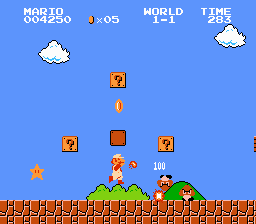
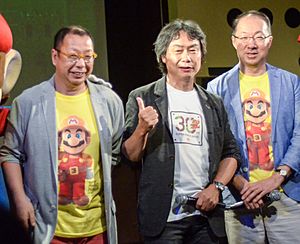
Super Mario Bros. was the first 2D side-scrolling game to feature Mario. It came out for the Nintendo Entertainment System (NES) in 1985. It was made by Nintendo's Shigeru Miyamoto and Takashi Tezuka. It followed the 1983 arcade game Mario Bros., which starred Mario and Luigi.
Super Mario Bros. created many key Mario elements. These include enemies like Goombas and Koopa Troopas, and characters like Bowser and Peach. It also introduced the three main power-ups: the Super Mushroom, Fire Flower, and Super Star. The "Super" in the title came from adding the Super Mushroom to the game. Mario and Luigi must save Princess Peach from Bowser in the Mushroom Kingdom. The game has 8 worlds, each with 4 levels, for a total of 32 levels. Super Mario Bros. is one of the bestselling video games ever.
Super Mario Bros: The Lost Levels (known as Super Mario Bros. 2 in Japan) was the first sequel. It used the same game engine but added harder levels, weather, and new character moves. It was very difficult, so Nintendo of America didn't release it outside Japan at first. It later came out in 1993 as part of Super Mario All-Stars.
In Super Mario Bros. 2 (known as Super Mario USA in Japan), Mario and his friends try to defeat the evil frog Wart. This game was originally a different Japanese game called Yume Kōjō: Doki Doki Panic. It was changed into a Mario game for other countries. A cool thing about this game is that you can play as Mario, Luigi, Princess Peach, or Toad. Each character has different moves. This was also the first Super Mario game with a life meter.
Super Mario Bros. 3 has eight themed worlds. Each world has levels and bonus stages shown on a map. You can sometimes skip levels or play them out of order. The end of each world has a fight against one of Bowser's seven Koopalings on an airship. This game added many new power-ups, like the Raccoon Suit for flying.
Super Mario Land was the first handheld Super Mario game, released for the Game Boy in 1989. Mario tries to save Princess Daisy from the spaceman Tatanga. It has 12 levels across 4 worlds.
Super Mario World came out for the Super Nintendo Entertainment System. It has nine worlds shown on one big map. It's a direct follow-up to the Super Mario Bros. games. Some levels have hidden exits that lead to different areas. New moves include a spin jump and riding Yoshi. The new Cape Feather lets Mario and Luigi fly.
Super Mario Land 2: 6 Golden Coins (1992) for Game Boy introduced Mario's rival, Wario. Wario took over Mario's castle! Mario has to collect six golden coins to get it back. This game was more like Super Mario World with a world map. It also added the Carrot power-up, which gives Mario rabbit ears to glide.
Super Mario World 2: Yoshi's Island (1995) for the SNES is unique. You play as Yoshi, carrying Baby Mario, to save Baby Luigi from Kamek. Yoshi has new moves like the flutter jump and making eggs from swallowed enemies. The game has a hand-drawn look. Many people loved this game.
1996–2005: Exploring in 3D
In the early 1990s, Shigeru Miyamoto thought about making a 3D Mario game. Super Mario 64 was developed for the Nintendo 64. It was the first 3D and open world game in the series. It was also a launch game for the Nintendo 64 console.
In Super Mario 64, each level is an enclosed area. You can explore freely without time limits. You collect Power Stars from paintings in Peach's castle to unlock new areas. The Nintendo 64's analog stick allowed for many precise movements. The game added new moves like punching and triple jumping. It was the first Super Mario game to have Charles Martinet voice Mario. Mario must save Princess Peach from Bowser again. The power-ups were different, like hats that gave temporary powers: the Wing Cap (for flying), Metal Cap (turns Mario into metal), and Vanish Cap (lets him walk through obstacles). Super Mario 64 is seen as a very important game for 3D video games. A remake, Super Mario 64 DS, came out for Nintendo DS in 2004/2005. It added Yoshi, Luigi, and Wario as playable characters.
Super Mario Sunshine (2002) was the second 3D Super Mario game. It came out for the GameCube. Mario and Peach go on vacation to Isle Delfino. But a Mario look-alike, Shadow Mario, messes up the island! Mario has to clean it with a water-squirting tool called F.L.U.D.D. You collect Shine Sprites to unlock new levels. Sunshine introduced Bowser Jr. as a bad guy. Yoshi also appears for Mario to ride.
2006–2016: 2D Games Return and Path-Focused 3D Games
After no new 2D games since 1995, New Super Mario Bros. was released for the Nintendo DS in 2006. Mario and Luigi try to save Princess Peach from Bowser Jr. The game looks 3D, but you play it in 2D, creating a 2.5D effect. Classic power-ups returned, along with new ones like the Mega Mushroom and Mini Mushroom.
Nintendo wanted to make games easier for everyone to pick up and play. This led to Super Mario Galaxy, released in 2007 for the Wii. It takes place in outer space. Mario or Luigi travel between "galaxies" to collect Power Stars. It added motion controls to the series. Each galaxy has planets and space objects to explore. The game's physics let you walk sideways or upside down on round planets.
New Super Mario Bros. Wii (2009) added 4-player co-op. It also had new power-ups like the Propeller Mushroom and Penguin Suit. All characters could ride Yoshi.
Super Mario Galaxy 2 (2010) was first planned as an expansion for Galaxy. It kept the same ideas and many power-ups. New power-ups included the Cloud Flower and Rock Mushroom. You could also ride Yoshi. This game got even better reviews than the first Galaxy.
Super Mario 3D Land (2011) for the Nintendo 3DS was the first attempt to mix 2D gameplay with a 3D environment. It made 3D games simpler to control. It was the first original 3D Super Mario game on a handheld console. It brought back old features, like the Super Leaf.
New Super Mario Bros. 2 (2012) for the Nintendo 3DS focused on collecting one million coins. It added elements like the Gold Flower, which turns items into coins.
New Super Mario Bros. U (2012) for the Wii U added a Flying Squirrel suit for gliding. It also had asymmetric gameplay, where one player on the GamePad could change the environment. New Super Luigi U (2013) was a harder DLC (downloadable content) package starring Luigi. The Nintendo Switch version, New Super Mario Bros. U Deluxe, includes both games and new characters like Nabbit and Toadette.
Super Mario 3D World (2013) for the Wii U was the sequel to 3D Land. It used similar gameplay. Up to four players could play together. It added the ability to turn into cats, letting you climb walls. It also let you create clones of your character. Princess Peach and Toad were playable, along with Mario and Luigi. Rosalina from Super Mario Galaxy also joined later.
Super Mario Maker (2015) for the Wii U lets players create their own levels. You can use styles from Super Mario Bros., Super Mario Bros. 3, Super Mario World, and New Super Mario Bros. U. You can share your levels online. Super Mario Maker 2 (2019) for Nintendo Switch added many new items, themes, and a world-builder.
Super Mario Run (2016) was the first official Super Mario game for mobile devices (iOS and Android). It's a side-scrolling game where your character runs automatically. You tap the screen to jump and avoid dangers. It also has a "Toad Rally" mode where you race against a computer-controlled Toad. Princess Daisy is playable in this game.
2017–2021: Back to Open-Ended Exploration
After some time, open-world 3D platformers like Super Mario 64 became popular again. Super Mario Odyssey (2017) for Nintendo Switch returned to this open-world style. It lets you explore freely, like in Super Mario 64 and Super Mario Sunshine.
Bowser's Fury (2021) was part of the Super Mario 3D World re-release on the Nintendo Switch. It also uses 3D open-world gameplay, similar to Odyssey.
2023: Super Mario Bros. Wonder
Super Mario Bros. Wonder is a 2D side-scrolling Super Mario game released on October 20, 2023. Playable characters include Mario, Luigi, Toad, Princess Peach, Princess Daisy, Yoshi, Nabbit, and Toadette. New power-ups include a fruit that turns you into an elephant and a flower that lets you create bubbles to capture enemies. When you touch a Wonder Flower, strange things happen to your character and the world! This is the first game to feature Kevin Afghani as the new voice of Mario and Luigi.
Remakes and Remasters
Sometimes, older games are updated and re-released for newer systems. This table shows some Super Mario remakes and remasters:
| Game | System | Year | Original game(s) | Original release year(s) |
|---|---|---|---|---|
| Super Mario All-Stars (+ Super Mario World) | Super NES | 1993/1994 | Super Mario Bros. | 1985 |
| Super Mario Bros.: The Lost Levels | 1986 | |||
| Super Mario Bros. 2 | 1988 | |||
| Super Mario Bros. 3 | 1988 | |||
| Super Mario World | 1990 | |||
| Super Mario Bros. Deluxe | Game Boy Color | 1999 | Super Mario Bros. | 1985 |
| Super Mario Bros.: The Lost Levels | 1986 | |||
| Super Mario Advance | Game Boy Advance | 2001/2002 | Super Mario Bros. 2 | 1988 |
| Mario Bros. | 1983 | |||
| Super Mario World: Super Mario Advance 2 | Game Boy Advance | 2001 | Super Mario World | 1990 |
| Mario Bros. | 1983 | |||
| Yoshi's Island: Super Mario Advance 3 | Game Boy Advance | 2002 | Super Mario World 2: Yoshi's Island | 1995 |
| Mario Bros. | 1983 | |||
| Super Mario Advance 4: Super Mario Bros. 3 | Game Boy Advance | 2003/2004 | Super Mario Bros. 3 | 1988 |
| Mario Bros. | 1983 | |||
| Super Mario 64 DS | Nintendo DS | 2004/2005 | Super Mario 64 | 1996 |
| New Super Mario Bros. U Deluxe | Nintendo Switch | 2019 | New Super Mario Bros. U | 2012 |
| New Super Luigi U | 2013 | |||
| Super Mario 3D All-Stars | Nintendo Switch | 2020 | Super Mario 64 | 1996 |
| Super Mario Sunshine | 2002 | |||
| Super Mario Galaxy | 2007 | |||
| Super Mario 3D World + Bowser's Fury | Nintendo Switch | 2021 | Super Mario 3D World | 2013 |
Images for kids
See also
 In Spanish: Super Mario para niños
In Spanish: Super Mario para niños


